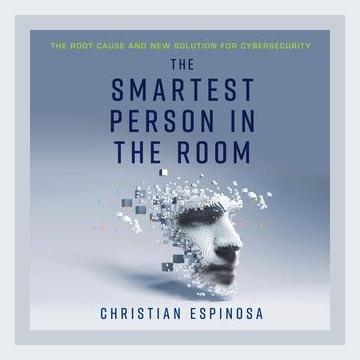Technology and Digital TransformationCybersecurity
Introduction
Christian Espinosa’s “The Smartest Person in the Room: The Root Cause and New Solution for Cybersecurity” delves into the intricate world of cybersecurity. Espinosa identifies the core challenges plaguing the industry, focusing on the human element rather than technology alone. The book leverages Espinosa’s experience to offer practical advice on improving cybersecurity by addressing the interpersonal dynamics and soft skills in security teams.
Chapter 1: Recognizing the Real Problem
Espinosa argues that the root cause of many cybersecurity issues is not technical in nature but rather the lack of effective communication and soft skills within security teams. He emphasizes that many security incidents occur due to misunderstandings, poor communication, and ineffectiveness in teamwork.
Actionable Advice: Enhance communication skills through regular training and incorporate team-building activities to foster better interpersonal relations.
Chapter 2: The Skillset Matrix
In this chapter, Espinosa introduces the Skillset Matrix, which categorizes essential skills into four quadrants: Technical Skills, Soft Skills, Problem Solving, and Stress Tolerance. He posits that a balanced development of all these areas is crucial for effective cybersecurity.
Example: A highly technically skilled professional might fail to address an issue effectively if they cannot communicate the problem and solution properly to their team.
Actionable Advice: Conduct regular assessments to identify skill gaps in all four quadrants and craft individualized development plans for each team member.
Chapter 3: Ego and Humility
Espinosa underscores the detrimental effects of excessive ego within cybersecurity teams. High ego can lead to poor collaboration, reduced information sharing, and a lack of learning.
Example: A team member with excessive ego might dismiss input from others, leading to overlooked vulnerabilities.
Actionable Advice: Promote a culture of humility by recognizing and rewarding collaborative efforts rather than individual achievements alone.
Chapter 4: The Importance of Soft Skills
The chapter illustrates how soft skills such as communication, empathy, and teamwork significantly boost the effectiveness of cybersecurity measures. Espinosa shares anecdotes of teams that failed despite technical expertise due to poor soft skills.
Example: A cyber incident response situation where the technical team struggled to communicate with the upper management, resulting in delayed and ineffective response.
Actionable Advice: Incorporate soft skills training into the regular development schema and emphasize their importance in project evaluations and daily tasks.
Chapter 5: Emotional Intelligence (EQ)
Emotional Intelligence, or EQ, is highlighted as a pivotal component for cybersecurity professionals. High EQ can mitigate stress, improve decision-making under pressure, and enhance team dynamics.
Example: An analyst with high EQ can navigate high-pressure situations calmly, making strategic decisions without succumbing to stress.
Actionable Advice: Implement EQ training programs and mindful leadership practices aimed at recognizing and managing both personal and team emotions.
Chapter 6: Frameworks and Methodologies
Espinosa introduces frameworks like the Secure Methodology™ designed to integrate soft skills with technical approaches, fostering a safer cyber environment.
Example: Using the Secure Methodology™ to blend technical audits with team communication exercises, ensuring both technical proficiency and efficient information flow.
Actionable Advice: Adopt and customize these frameworks within your organization for structured improvement in both technical and soft skill areas.
Chapter 7: The Role of Leadership
Leadership plays a crucial role in shaping the culture of cybersecurity teams. Espinosa emphasizes that leaders must embody the values of humility, continuous learning, and effective communication.
Example: A leader who takes time to mentor team members on both technical and soft skills sets the tone for a more cohesive and effective team.
Actionable Advice: Leaders should engage in regular feedback sessions, actively seek their own skill development, and foster an environment where continuous learning is valued.
Chapter 8: Building Trust
Trust is positioned as the cornerstone of a high-functioning cybersecurity team. Without trust, communication breaks down, collaboration falters, and security suffers.
Example: A scenario where a team lacking trust fails to share critical information, leading to an avoidable security breach.
Actionable Advice: Create trust-building rituals and transparent communication channels within your team to ensure that trust is maintained and reinforced.
Chapter 9: Continuous Improvement
Espinosa concludes by advocating for a continuous improvement mindset. Cybersecurity is an evolving field, and strategies must constantly adapt and evolve.
Example: Regular retrospectives after security incidents to learn and adapt processes accordingly.
Actionable Advice: Implement continuous improvement processes such as regular team debriefs, updated training programs, and periodic reassessments of both technical skills and soft skills.
Conclusion
Christian Espinosa’s “The Smartest Person in the Room” effectively shifts the focus from purely technical solutions to the holistic development of cybersecurity professionals. By integrating technical prowess with soft skills and promoting a healthy team culture, Espinosa provides a comprehensive strategy for addressing the root causes of cybersecurity issues.
Overall Actionable Advice: Merge technical training with soft skills development, foster a culture of humility and continuous learning, and adopt frameworks that balance both aspects for a robust cybersecurity strategy.
References
Espinosa, C. (2021). The Smartest Person in the Room: The Root Cause and New Solution for Cybersecurity. Lioncrest Publishing.
